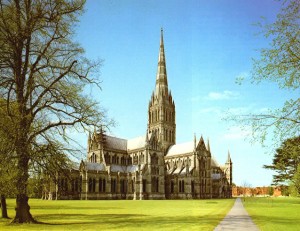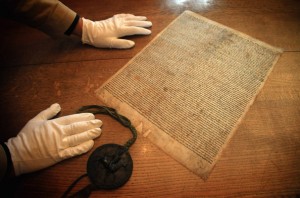History Of Salisbury Cathedral
A new church for a new age, learn the story of the perfect English cathedral!
Salisbury Cathedral was the vision of one remarkable man, Bishop Richard Poore (1194-1217). Built shortly after the Fourth Lateran Council in Rome, it expressed new theological thinking in architectural terms. Bishop Poore even published a new liturgy for his new cathedral, ‘The Use of Sarum’, which came to be used throughout medieval England.
The cathedral was laid out on a virgin site on water meadows, and remarkably the whole structure stands on foundations Just 1.2m (4ft) deep. As the cathedral was built in just 38 years, its interior is stylistically coherent and is the finest extant example of early English Gothic architecture. It has 365 separate windows (the number of days in the year) and 8,760 marble pillars (the number of hours in a year). Constructed from 60,000 tons of Chilmark Stone and 10,000 tons of Purbeck ‘Marble’, over 420 tons of lead sheeting covers the cathedral’s four acres of roof.
The tower and spire were constructed between 1310 and 1333, and added an extra 6,500 tons to the building causing subsidence, a problem from which the cathedral has suffered ever since. After the erection of the tower and spire in the mid-14th Century, the building was substantially complete.
 The only additions were the beautiful Hungerford and Beauchamp chantries at the east end, but they were sadly demolished in the late 18th Century, when James Wyatt, nicknamed ‘the Destroyer’, reordered both the cathedral’s interior and the Cathedral Close. Moving medieval tombs and screens, Wyatt even demolished the cathedral’s free-standing bell tower and leveled the graveyard. The cathedral was again restored by Sir George Gilbert Scott in the late 19th Century, and conservation work has continued ever since.
The only additions were the beautiful Hungerford and Beauchamp chantries at the east end, but they were sadly demolished in the late 18th Century, when James Wyatt, nicknamed ‘the Destroyer’, reordered both the cathedral’s interior and the Cathedral Close. Moving medieval tombs and screens, Wyatt even demolished the cathedral’s free-standing bell tower and leveled the graveyard. The cathedral was again restored by Sir George Gilbert Scott in the late 19th Century, and conservation work has continued ever since.
Inspiring artists and writers over the centuries, Salisbury Cathedral was used as the model for the fictional Kingsbridge Cathedral in Ken Follett’s novel The Pillars Of The Earth.
Magna Carta
 The best preserved of the four surviving original copies of the Magna Carta (Latin for “Great Charter’) is housed in Salisbury Cathedral’s Chapter House. At the time it was simply a solution to a political crisis, but it has become recognized as a cornerstone of liberty influencing much of the civilized world.
The best preserved of the four surviving original copies of the Magna Carta (Latin for “Great Charter’) is housed in Salisbury Cathedral’s Chapter House. At the time it was simply a solution to a political crisis, but it has become recognized as a cornerstone of liberty influencing much of the civilized world.
The Salisbury copy came to the cathedral because Elias of Dereham was at Runnymede in 1215 when the original was signed by King John. Elias was given the task of distributing copies of the charter and when he became a canon at Salisbury, he brought one with him. To help preserve the Magna Carta, the copy at Salisbury is kept in a temperature and humidity controlled environment, and away from the effects of UV radiation.

